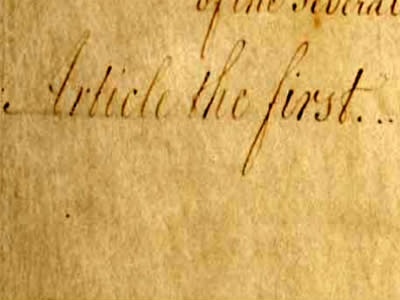The Nevada cattle standoff and the First Amendment
An old-fashioned standoff between Nevada rancher Cliven Bundy and federal officials seems to be over now, but the event has started even more talk about the use of “First Amendment zones” at public protests.
Bundy and the federal government have been at odds for decades over land grazing rights. In 1993, federal officials tried to charge Bundy monthly fees of about $1.35 per cow-calf pair if they grazed on public lands, which are also the home of the threatened Mojave Desert tortoise.
Bundy hasn’t recognized federal jurisdiction in the case, saying that his family and Mormon ancestors used the land since the 1880s, before it was in federal hands and before the Bureau of Land Management existed.
About 1,000 cattle were on the lands when federal officials started to round them up in the past week. The story became front-page news in the Western states and a topic of intense interest on the Internet and social media.
In response, an estimated 1,000 protesters appeared at the Bundy ranch and at federal lands to object and express their First Amendment rights. There were several confrontations and some arrests, but eventually BLM and National Park Service employees released cattle they had gathered and gave up the effort.
For now, the issue heads back to the federal court system, as two debates continue about states’ rights and the BLM’s role in the region.
The third debate, which became very heated, was the use of “free speech” or “First Amendment” zones to contain protesters at the scene.
One strong opponent of the zones was Nevada Governor Brian Sandoval.
“No cow justifies the atmosphere of intimidation which currently exists nor the limitation of constitutional rights that are sacred to all Nevadans,” Sandoval said in a statement last week. “The BLM needs to reconsider its approach to this matter and act accordingly.”
As protesters funneled into the area, they started protesting about the free-speech protest zones.
Tod Story, executive director of the ACLU of Nevada, told a Nevada newspaper that the First Amendment zones impeded free speech. “We don’t like the idea of people being cordoned off or corralled and told where they can and cannot express themselves,” Story said.
Officials with the BLM and National Park Service set up two zones with orange fencing. Park National Service spokeswoman Christie Vanover said Tuesday they were created to promote free speech and not hinder it.
“While anybody can express their free speech any time on open public lands in accordance with the codes and ordinances that exist, there are temporary closures of some of the public lands related to this impound operation and those are in place for public safety,” Vanover said. “So we identified two areas where the public could safely and conveniently express their opinions without having to go through the codes and ordinance process and apply for permits.”
The zones didn’t last long and were taken down by federal officials on Thursday.
The First Amendment zone debate isn’t limited to cattle ranches. It is a hot topic related to use of similar zones on other National Park Service lands, at college campuses, and at protests related to abortion facilities.
The Park Service has been refining its zone policy since a ruling in 2010, when the U.S. Court of Appeals for the District of Columbia Circuit said the Park Service’s permit policy was too restrictive.
“The Constitution does not tolerate regulations that, while serving their purported aims, prohibit a wide range of activities that do not interfere with the Government’s objectives,” the court said.
On campuses, opponents of free speech zones at colleges are winning legal battles. Last week, a student at Virginia community college won his fight with the school after he was confronted by police for preaching on campus.
The free-speech zone is also involved in two current Supreme Court cases. In the case of McCullen v. Coakley, the Court is considering a Massachusetts law that bars protests within 35 feet of an abortion facility.
The Court also heard the case of Wood v. Moss last month, which is about how protests are managed as related to presidential public appearances and visits.
At the heart of the issue are prior Court rulings about the time, place and manner of protests, if there is a narrow reason for blocking them, if they are content-neutral, and if restrictions leave open other avenues of communication.
For now, the BLM said this weekend that it will pursue it case against Cliven Bundy “administratively and judicially.” But the Bundy case is not the only disagreement in the Western states over land use, and the appearance of First Amendment Zones at other future protests could return as a point of contention.
Scott Bomboy is the editor in chief of the National Constitution Center.
Recent Constitution Daily History Stories
Congressman cussed out after pay raise request
10 odd facts about Abraham Lincoln’s assassination


